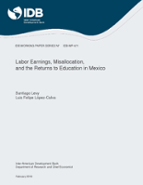Labor Earnings, Misallocation, and the Returns to Education in Mexico
Date
Feb 2016
Over the last two decades Mexico has had an open trade regime, experienced macroeconomic stability, and made substantial progress in education. However, average workers¿ earnings have stagnated and earnings for workers with more schooling have declined, compressing the earnings distribution and lowering the returns to education. This paper hypothesizes that these developments are explained by large and persistent of distortions that misallocate resources towards less productive firms, since these firms are substantially less intensive in educated workers than more productive ones. It is shown that at the same time that the relative supply of workers with more years of schooling has increased, misallocation of resources toward less productive firms has persisted. These two trends have generated a widening mismatch between the supply and demand for educated workers. The paper decomposes worker earnings into observable and unobservable firm and individual worker characteristics and simulates a counterfactual earnings distribution in the absence of misallocation. Under the counterfactual, earnings differentials across schooling levels would increase, as would the returns to education. In parallel, earnings differentials, rather than narrowing over time, would widen. The paper concludes by arguing that the persistence of distortions that misallocate resources toward lower-productivity firms impedes Mexico from taking full advantage of its investments in the human capital of its workers.




